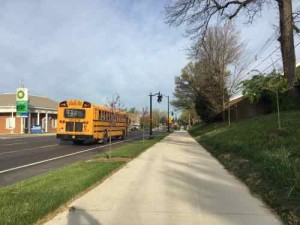The ‘Great Streets’ Project on Natural Bridge, Part 3

The last two days I’ve shown you before & after photos of the Great Streets makeover/road diet of Natural Bridge Rd — a 1.7 mile stretch from Lucas & Hunt on the East end to Hanley Rd in the West end (map):
In May 2012 I posted about the upcoming project, see Redeveloping Natural Bridge & The UMSL South MetroLink Station.
Many have said it now looks better, or is prettier. True, but it functions & feels better — at least for pedestrians in my experience. I’ve also driven the stretch both directions, before and after, but that was on weekends. It also felt better to me as a motorist.
One complaint I received last month is that driving it now can take quite a bit longer. Only two options — either it does take longer or the perception is that it takes longer. I have no method to determine which it is.
The number of traffic signals seems about the same as before, I didn’t tally the number, though that could be done via Google Street View. The major change was reducing the number of driving lanes per direction from two to one. This freed up a significant amount of the public right-of-way (PROW) for use by pedestrian amenities.
Where such road diets have been performed, the actual number of vehicles through the area, in a given period, remains the same as before. Are there times where it might take longer? No doubt. But any speed that was achieved during the prior decades was at the expense of other users of the PROW. Before this project vehicles traveled too fast. Two wide lanes per direction made drivers think it was OK.
Posted speed limits have little bearing on vehicle speed — motorists drive at speeds that feel comfortable to them. Give them only one narrow lane per direction and they’ll slow down. However, they can’t pass like they used to. To those who like to race to the next red light, it must be frustrating being behind someone going at or below the posted speed limit.
I plan to return during an afternoon rush hour to see if I can see backups at any of the lights, it’s possible the timing needs to be adjusted.
On the other hand, I received an email from someone who says his significant other walks from home to/from the MetroLink station weekdays — the project is a huge improvement.
While there are some issues I pointed out in the first two parts, the public right-of-way (PROW) is now well-balanced between vehicles & pedestrians. Designing streets that are great for those of us who are disabled also turns out to be great for every pedestrian. Hopefully in the new couple of decades we’ll see new urban infill in the various commercial areas along this stretch.
— Steve Patterson
This one statement is at the heart of ANY discussion of the use(s) of the PROW: “Before this project vehicles traveled too fast.” That ranks right up there with “Get off my lawn!” We all have our own opinions about what is “too fast” or “too slow”, “too crowded” or “too empty” or messy or orderly. Ask people who live pretty much anywhere and many will say traffic is “too fast”, yet the police seem to have little problem making their quotas every month. Much like the people who say they’ll “never shop at Walmart”, what we say and what we do are two very different things. Once we get off of our own block and out of our own neighborhood, most of us want to get to where we’re going quickly, safely and efficiently, and it shows. This project shifts the needle, here, more in favor of non-vehicular users, and that’s probably a good thing. But my concern remains, as illustrated in yesterday’s post, that focusing massive amounts of spending in small, well-defined areas, leaves much larger areas with little or nothing in even minor improvements. The same thing happened on South Grand – the work there is great on the few blocks where it happened, but for miles to the south, nothing has changed. Personally, I think that we’d be much better off if we quit focusing on “photo-op” projects (like this one) and, instead, invest the same money (and more!) in building thousands of needed curb ramps and laying miles of new sidewalks WHERE THERE ARE NEEDED NOW! Yes, a wider sidewalk WILL make “pedestrians feel protected from passing vehicles” . . . for the few blocks where it’s installed, but, as you well know, it really sucks when the new ends and the old is a hot mess of cracked and missing slabs, insurmountable curbs and bridges without pedestrian amenities!
The trees and light posts on the curved section of this road near Normandy Middle School obstructed a teacher’s view and he hit me on my bike exiting the school lot. It was an accident and I am healing okay. He was accelerating when he hit me to beat traffic. While it is lovely, it is not practical at all to have so many vertical obstructions in the plane of view of a bike lane.